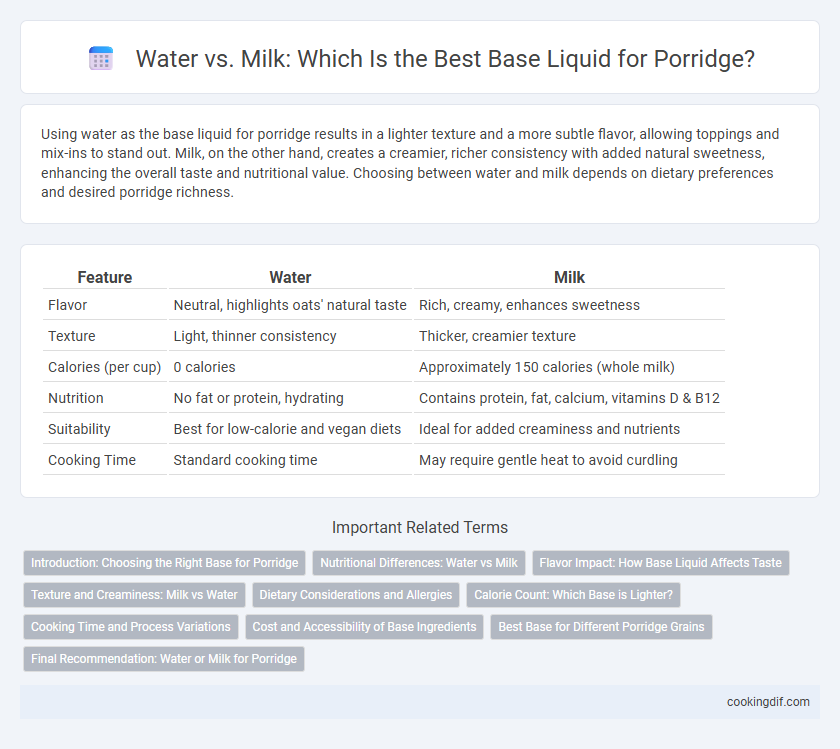Using water as the base liquid for porridge results in a lighter texture and a more subtle flavor, allowing toppings and mix-ins to stand out. Milk, on the other hand, creates a creamier, richer consistency with added natural sweetness, enhancing the overall taste and nutritional value. Choosing between water and milk depends on dietary preferences and desired porridge richness.
Table of Comparison
| Feature | Water | Milk |
|---|---|---|
| Flavor | Neutral, highlights oats' natural taste | Rich, creamy, enhances sweetness |
| Texture | Light, thinner consistency | Thicker, creamier texture |
| Calories (per cup) | 0 calories | Approximately 150 calories (whole milk) |
| Nutrition | No fat or protein, hydrating | Contains protein, fat, calcium, vitamins D & B12 |
| Suitability | Best for low-calorie and vegan diets | Ideal for added creaminess and nutrients |
| Cooking Time | Standard cooking time | May require gentle heat to avoid curdling |
Introduction: Choosing the Right Base for Porridge
Selecting the ideal base liquid for porridge significantly impacts its texture and nutritional value. Water creates a lighter, more hydrating porridge with fewer calories, ideal for cleansing and weight control, while milk provides a rich, creamy consistency packed with protein, calcium, and vitamins. Opting between water and milk depends on dietary goals, taste preferences, and desired nutritional benefits.
Nutritional Differences: Water vs Milk
Using water as the base liquid for porridge results in a lower calorie and fat content, making it suitable for low-calorie diets and hydration without added sugars. Milk, particularly whole or semi-skimmed, enhances the porridge's protein, calcium, and vitamin D levels, promoting bone health and prolonged satiety. Choosing milk increases overall nutrient density, while water keeps the dish light and hydrating, impacting both energy intake and nutritional benefits.
Flavor Impact: How Base Liquid Affects Taste
Using milk as the base liquid in porridge produces a creamier texture and richer flavor profile, enhancing the natural sweetness of oats and adding dairy notes. Water-based porridge allows the oat flavor to remain more pronounced and can be a lighter option for those seeking a less rich taste. The choice between water and milk ultimately influences the porridge's mouthfeel and overall flavor depth, with milk creating a more indulgent experience.
Texture and Creaminess: Milk vs Water
Using milk as the base liquid for porridge results in a richer, creamier texture due to its natural fats and proteins that enhance mouthfeel and thickness. Water creates a lighter, more fluid consistency, often yielding a thinner porridge that highlights the grain's natural flavors without added creaminess. The choice between milk and water significantly influences the porridge's overall creaminess and texture, with milk producing a more indulgent and velvety experience.
Dietary Considerations and Allergies
Water-based porridge offers a low-calorie option suitable for those monitoring calorie intake or managing lactose intolerance, while milk-based porridge provides added protein, calcium, and vitamin D, beneficial for bone health but may trigger allergic reactions in individuals with dairy allergies or lactose sensitivity. Choosing water as the base eliminates common allergens and reduces fat content, making it ideal for vegan or dairy-free diets. Milk alternatives like almond or oat milk can offer a middle ground, supplying nutrients without the common dairy allergens.
Calorie Count: Which Base is Lighter?
Using water as the base liquid for porridge results in a significantly lower calorie count compared to milk, typically providing zero to minimal calories per serving. Milk, especially whole or full-fat varieties, adds approximately 60-150 calories per cup, depending on the type, contributing to a richer but heavier nutritional profile. For those prioritizing a lighter calorie intake, water is the optimal base choice for preparing porridge.
Cooking Time and Process Variations
Water-based porridge cooks faster due to its lower viscosity, allowing oats to absorb moisture more quickly and reduce overall cooking time by several minutes. Milk as a base creates a creamier texture but requires longer heating, increasing the risk of scorching and necessitating more frequent stirring during cooking. Variations in cooking process include adjusting heat settings and stirring frequency to prevent milk from curdling, whereas water-only porridge demands less attention and offers a quicker preparation method.
Cost and Accessibility of Base Ingredients
Water is the most cost-effective and accessible base liquid for porridge, as it is readily available and free or low-cost in most households. Milk, while providing a creamier texture and added nutrients, often incurs a higher expense and may be less accessible in regions with limited dairy supply or lactose intolerance concerns. Choosing water as the base liquid maximizes affordability and ensures porridge can be prepared universally without additional financial burden.
Best Base for Different Porridge Grains
Water enhances the natural flavors and texture of oats and rice porridge, making it the best base for grains with subtle taste profiles. Milk provides a creamier consistency and richer taste, ideal for wheat and barley porridges that absorb liquid well and benefit from added fat content. Choosing between water and milk as a base liquid depends on the specific grain's absorption qualities and desired flavor intensity.
Final Recommendation: Water or Milk for Porridge
Using water as the base liquid for porridge creates a lighter texture with fewer calories, making it ideal for health-conscious individuals or those seeking a neutral flavor that can be enhanced with toppings. Milk adds creaminess and natural sweetness while boosting protein, calcium, and vitamin D content, which benefits bone health and satiety. For a balanced approach, blending water and milk provides a rich texture without overwhelming richness, catering to varied taste preferences and nutritional goals.
Water vs milk for base liquid Infographic

 cookingdif.com
cookingdif.com